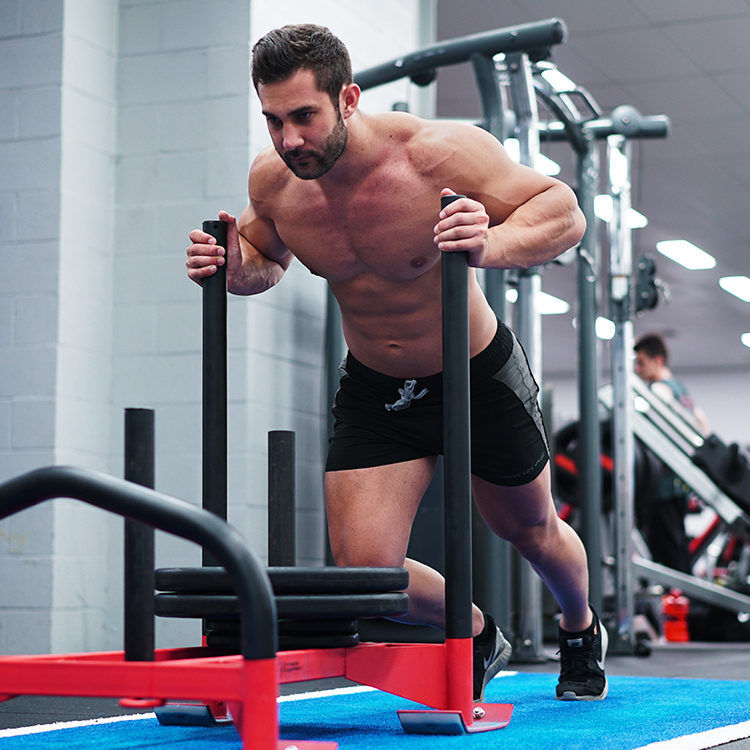If you want to train your back, you’ve got to be willing to put in some serious work.
Think about it. Your back takes up a lot of real estate. And to engage all those muscles, you’ve got to be willing to do some heavy lifting to hit all the muscles back there.
But there’s a bit of a challenge with training your back, compared to training a lot of other muscles. You can’t always feel your back muscles at work.
Notice that the last time you pumped out some reverse grip barbell rows?
Part of the problem is more of a mind-body connection than anything else. You can’t see your back in the mirror like you can cranking out hammer curls watching your bicep bulge at the top of every rep.
But if you’re using good form for every lift to train your back, you’re going to grow. And you’re going to get stronger.
It’s no secret that a lot of people in the gym like to focus on training chest, arms, shoulders, and abs. But training the back? It just doesn’t get as much attention.
But it should.
Benefits of a Stronger Back
Training your back can help you develop that classic V-shape (think Arnold Schwarzenegger in a back double bicep pose.) Plus a stronger back will help:
- Improve posture
- Strengthen your core
- Treat chronic lower back pain.
- Reduce the risk for injury when you hit the squat rack or show up for deadlift day
Forget about aesthetics for a minute. Did you know an estimated 80 percent of people will experience back pain at some point in time?[1]
And for some people, lower back pain is a chronic condition, meaning it’s always there. That’s going to make it tough to squat, deadlift, or even enjoy working out.
Fortunately, research also shows that training your back can improve flexibility, increase muscle strength, reduce pain, and improve quality of life.[2]
And you thought being able to spread your wing and show off your lats was all that really mattered about training your back. It’s OK, I won’t judge.
Get to know your back muscles
Here’s a crash course on the muscles of your back. The major muscles of your back include:[3]
Trapezius
These are triangular muscles in the upper back that help support your neck and shoulders. You can hit the trapezius on back day with pull-ups or train them on shoulder day, for example.
Rhomboids
These muscles are in the middle of your back and allow you to square your shoulder. Reverse flyes are one of the classic lifts to train the rhomboids.
Teres major
Want to really get your lats look huge? The teres major is the muscle near the top of your lats that helps you pull your arm back to throw a baseball or crank out some one-armed dumbbell rows.
Latissimus dorsi
If you’ve spent any time in the gym, you probably know the “lats” are the muscles that define that V-shape and run down the side of your body from your armpit to just above the waist. Pull-ups, pull downs, and rows target the lats.
Erector spinae
Here’s a group of muscles that don’t get the kind of buzz that triceps and biceps do. But the erector spinae muscles supports your spine. And the stronger they are, the more you’re going to be able to handle deadlifting and other heavy lifts when you’re standing.
High-Volume Back Training
There’s more than one way to train your back. The number of reps and sets partly depends on your goal to build muscular endurance, strength, or size. If you’re going for gains to build a bigger back, high-volume training works.
Not too long ago, I had the chance to take a trip to Melbourne for a back training day with Muscle Mania Pro Kwame Duah at Doherty's Gym. This back training session was tough. Check it out:
| Exercise | Sets | Reps |
| Wide-Grip Pull-Ups | 10 | 10 |
| Superset: Hammer-Grip Pull-Ups | 5 | 5 |
| Superset: Hanging Lat Stretch | 5 | 5 second stretch |
| One-Arm Bent-Over Dumbbell Rows | 5 | 10 |
| Bent-Over Barbell Row | 5 | 10 |
| V-Bar Lat Pull-Down (As many reps as possible in 1:00) |
5 | AMRAP in 1 minute |
A few things to keep in mind:
- Limit using your biceps for back exercises. For example, the higher you go on a pull-up, the more your biceps will assist with the movement. Let your lats do the work.
- Rowing exercises. If you noticed your biceps helping a lot to complete a rep, drop the weight so your back is doing more of the work.
- Time under tension. The timed V-Bar Lat Pull-Down is a time under tension exercise. You’re trying to pump as much blood into your muscles as possible with each set to stimulate growth.
- Stretch. Of all the different muscle groups in the body, the lats are among the most common to be tight. Warm-up properly and stretch your back and lats before lifting heavy.
Want a customized training plan to help you reach your fitness goals? Get your own training and nutrition plan to shred fat, build muscle, or complete a transformation.
References
- Rubin, D., (2007). Epidemiology and risk factors for spine pain. Neurological Clinics. From: https://www.ncbi.nlm.nih.gov/pubmed/17445733.
- Chang, W., et al. (2015). Effects of a strengthening program for lower back in older women with chronic low back pain. Journal of Korean Academy of Nursing. From: https://www.ncbi.nlm.nih.gov/pubmed/19122492.
- Gest, T., et al. (1995). MedCharts Anatomy. ILOC, Inc. New York: NY.

